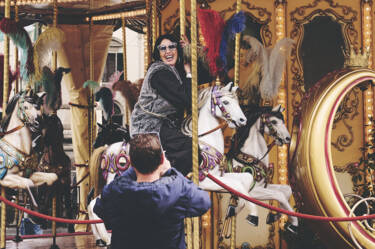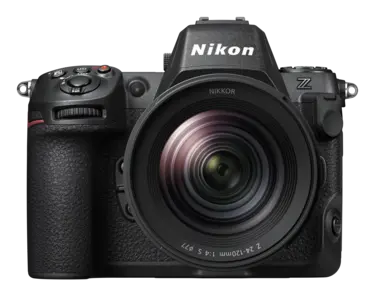Prime movers

From zoom to prime, why a ‘nifty-50’ fixed focal length can next-level your creativity
For many aspiring photographers and videographers, a zoom lens is the first thing to be found in their kitbag, as it offers great versatility, convenience and – importantly when starting out – an affordable price point. Many camera bundles feature a 24-70mm length ‘kit lens’. With its focal length range from pretty wide to a medium telephoto, it’s a real Swiss Army knife of a lens, making it an automatic choice to get your show on the road. The NIKKOR Z 24-70mm f/4 S is a wonderful lens, being flexible, portable and with S-line optics that make it super sharp.
So why would you even think about getting a prime, i.e. fixed focal length lens? The fact is that, for creativity and image quality, the move to a prime lens with its large aperture – particularly the 50mm – can be a transformative step.

Use that extra distance to allow action to happen in front of you when out and about. Z6II + NIKKOR Z 50mm f/1.4, 1/200 sec, f/1.4, ISO 100, ©Dom Salmon
Optimus prime?
The 50mm lens is one of the most popular choices for photographers as a first fixed focal lens, but why? First, and key, it offers a very natural field of view that very closely mimics how we see the world with our own eyes (hence it being dubbed a ‘standard’ lens). This makes it an excellent choice for a variety of photography styles, from portraits and street photography to video and low-light shooting.
It’s also one that’s making a return to style. For a while, this natural field of view, felt a bit ‘meh’ – it’s not super wide and dramatic, but nor is it very long, squishing distances together. It started to feel a bit ‘jack of all trades’ as a lens. I had the legendary AF-S NIKKOR 50mm f/1.8G (and still do) and, despite its constantly beautiful results, it got used less and less. But thanks to the new NIKKOR Z 50mm f/1.4, I’m in love with this focal length all over again.

A fifty is a great product shot length, which looks just ‘right’ with a very natural perspective. Get it on a tripod and stop down – I’m at f/1.6 here. Z6II + NIKKOR Z 50mm f/1.4, 1.6 secs, f/16, ISO 100, ©Dom Salmon
Some reasons to love a fast five-o:
Superior images
Prime lenses typically offer sharper images compared to zoom lenses thanks to fewer glass elements and a simpler optical design. Thank you physics! The new Z mount and its accompanying NIKKOR Z lenses really show off the extra edge-to-edge sharpness of Nikon’s modern optical tech.
Super speedy
Many 50mm lenses come with a maximum aperture of f/1.8, f/1.4 (or even f/1.2!), allowing for a very beautiful background blur (bokeh) and also giving you the ability to get great results even in very low light. Now f/1.4 is super tricky for focusing but, with the autofocus tracking down to a single eye in your Nikon mirrorless, you can be pretty confident the key element in your frame will be sharp every time, even when it’s moving. Add to this that even in the darkest setting you can get a great image without having to push up your ISO, and so your image noise. In video, this means you can be a lot braver in keeping your look and lighting very natural so you don’t have to reach for your LED panel light every time.
Lightweight and compact
With their multiple optics and moving parts, zooms can get pretty heavy, especially when you are working a long day. By comparison, a 50mm prime is small and lightweight, so it’s great for hand holding, especially in video, and it makes your kit bag mercifully lighter for travel. While I was using the NIKKOR Z 50mm f/1.4, my kit had shrunk to my Z6II, the lens and a tiny handheld LED light. I even left the tripod at home.

Valentina in her jewellery workshop, Linfa Studio Gallery, Florence. With a slightly longer focal length you can create distance to your subject allowing them to feel more natural. Z6II + NIKKOR Z 50mm f/1.4, 1/50 secs, f/2, ISO 160, ©Dom Salmon
The fifty ways
When you get your prime lens out and put your 24-70mm back into your kit bag, you might realise the flexibility of a zoom you thought was simply indispensable was maybe just a convenience. Even as a predominately prime user, when I got the NIKKOR Z 50mm f/1.4, it helped me snap out of the stale “video interview – 35mm, stills… portrait? 85mm” rut I’d got myself into.
So here are some ideas for challenges you can use to start making your 50 super-nifty.
- Get moving
Instead of zooming, get moving. Try different perspectives – crouch low, shoot from above or experiment with different distances, as sometimes you are cheating yourself by using your zoom to frame your shot. Plus, remember that with Nikon Z sensors there’s a lot of detail in your digital image, especially if you shoot in RAW, so you can always crop in later if you can’t get up close and personal.
- What’s the story?
Unlike the classic 85mm focal length for people portraits (a classic ‘studio shoot’ look), the 50mm focal length is great for ‘environmental portraits’ i.e. where you want to include some background to give your image a narrative quality and sense of place – without the reduction of the subject’s importance in the frame that can happen with the wider 35mm. From a blurry bookcase to a pin-sharp landscape, what can you show in the background of your subject to tell your audience more about them? And hit the streets. You’ll be surprised by the difference in the stories you can tell with this slightly tighter field of view compared to the classic 35/40mm ‘street-photography’ length. It’s just that little bit closer, making it easier to put your audience in the action rather than simply observing it.
Surprisingly cinematic
A 50mm lens isn’t just for photography – it’s also a fantastic tool for video. Yes, you might miss the convenience of your zoom lens, but your 50 prime’s secret skills can unleash a ton of creativity:
- Natural perspective
The 50mm mimics how the human eye sees, making it a great choice for relaxed and natural-feeling storytelling, especially for interviews and documentary. In a world of very close-up, fishbowl video we see every day from smartphones, your footage will really stand out. - Smooth background blur
Using that wide aperture creates a professional, filmic look, with soft backgrounds that draw attention to the subject. Instant cinema! Again, autofocus is your friend here. - Controlled depth of field for focus transitions
Use shallow focus for dramatic pull-focus effects, where one subject fades into focus as another blurs out. A little cheesy sometimes, but surprisingly effective for changing the narrative in a single take. Anyway, Spielberg does it all the time, so who am I to argue?
Why it’s time for a prime
All in all, moving from a zoom lens to a prime may feel like a limitation at first but, in reality, it’s a great gateway to helping you think more creatively. A prime lens challenges you to think more about composition, framing, and storytelling, forcing you to engage with your environment. And when you do that, you’ll stop being a passive observer and become a true creator.
Nifty indeed!
Discover the NIKKOR Z 50mm f/1.4
Featured products
More by Dom Salmon

Unlock greater creativity










